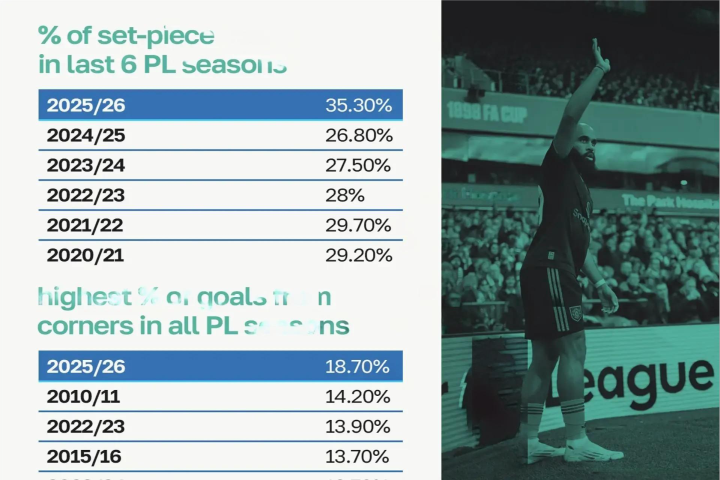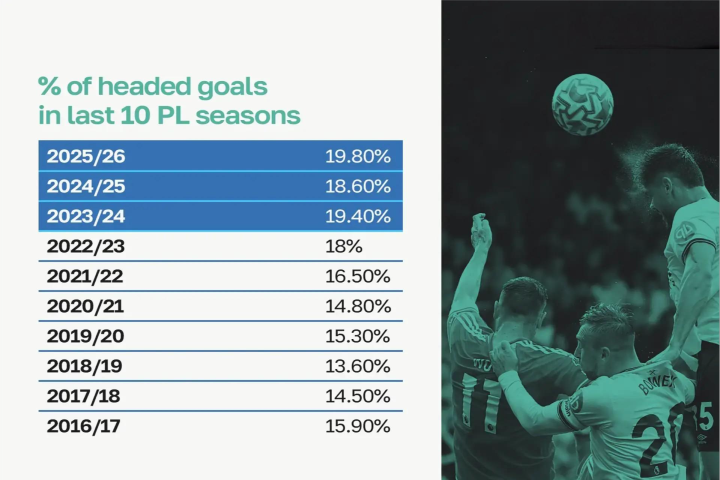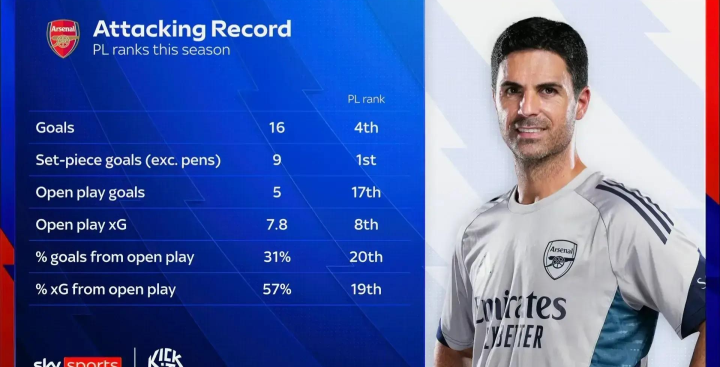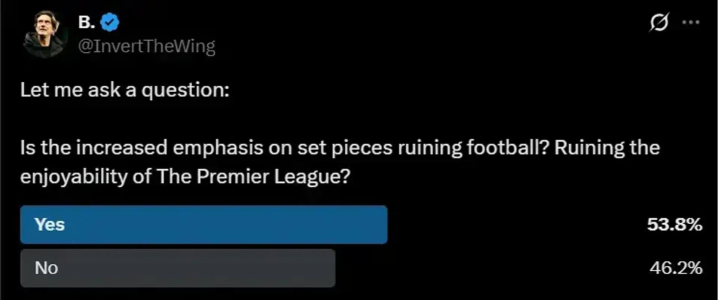Has set piece completely dominated the Premier League?
More than a third (35.3%) of goals have come from set pieces, up from 26.8% last season.
The same is true for corner kicks.

The proportion of goals scored with headers in the 2025/26 season also reached a record 19.8%, the highest value since 2000. But this is actually part of an ongoing upward trend in recent years.

Meanwhile, goals per game have fallen - it is the lowest since 2017/18 and 0.6 fewer than two years ago (meaning around five fewer goals per game than in 2023/24).

Long foul balls deserve a separate mention - they have become a phenomenon in their own right.
Long-distance throw-ins are all the rage in the Premier League - teams have learned to use them to score goals
Naturally, the protagonist of this set-piece revolution is Arsenal, led by set-piece expert coach Nicolas Joffe.
Only 6 of their 18 goals came from open play, with the other 12 coming from set pieces (10 from corners or free kicks, and 2 from penalties).
With such data, they firmly occupy the top spot in the standings. Before the start of the last round of games, data released by Sky Sports added fuel to the debate: Arsenal ranked 19th-20th in the league in terms of the proportion of goals scored in sports games and the proportion of expected goals scored in sports games, and ranked 17th in the total number of goals scored in sports games.

We will talk less about long balls and vertical play because the differences in this area are not that significant. For example, the proportion of long balls this season is 11.5% (compared to 10.5% last season), but that number will be the same in 2022/23 and even higher in 2021/22, at 12.2%. Nonetheless, it is precisely those teams that play more directly, such as Bournemouth, Sunderland, Crystal Palace, etc., that are surprising with their results.
Average effective game time has also dropped slightly, although not significantly - 55 minutes and 12 seconds this season compared to 57 minutes last season.
Fans and journalists complained - but there were many who countered
Complaints on social media surged during Premier League match days.
These complaints have received a lot of attention, and a considerable number of fans agree with the view that "the league is now unwatchable."

A survey shows that the growing influence of set pieces has led at least half of viewers to say: "Yes, it ruins the enjoyment of the Premier League."

Even reporters have joined the discussion. A writer for the Daily Telegraph recently published an article titled: "The Premier League is becoming like the NFL, and that's a bad thing." The article reads:
"Hooray. Direct football is back. Quick forwards. No more tiki-taka - or in the words of Sam Allardyce - 'tippy-tappy'. No more playing from the back. Getting the ball into the box. Heck, even kicking for throw-ins.
Instead, the Premier League went backwards. This is not the case in the Premier League this season, far from it. But this season has seen a worrying glorification of more direct football - as if that's a good thing - and the gleeful declaration that that's how football should be played. It's even more exciting. We're expected to praise players who can throw long throw-ins and be enamored of those who block opponents in corners. "
But there is another point of view, and it is well-argued:
- In a league as powerful as the Premier League, set pieces are often the only effective way to crack a compact, well-drilled defensive system.
- Due to the intensive schedule, coaches simply do not have time to practice complex offensive routines, so they focus on set pieces that are easier to rehearse.
- Ultimately, set pieces have always been an important part of football.
The debate spread to coaches and players.
The discussion has spread beyond social media and commentators' studios to the head coach and the players themselves.
Schmeichel directly pointed the finger at Arsenal: "I don't want to disrespect them, but their style of football is annoying. This tactic aims to exploit the opponent's weaknesses while waiting for opportunities from set pieces. Arteta... let your team play football! "
Soon, this topic appeared at the press conference. Liverpool coach Slott expressed his frustration: "Now it seems that every Premier League game is about set pieces. We rarely conceded points from set pieces last season so we have to prove it was just bad luck. I've seen teams win games from set pieces. "

Chelsea coach Maresca took a different view: "If you score after a corner kick, how did you win the corner kick? That's right - through mobile warfare. It’s not something separate from the game, offense or defense. This is football. Set pieces are part of football. "
Everton coach Moyes also expressed the same view: "We have gone through a period where people will say, 'I don't want to watch this anymore, I want to turn off the TV.' 'But in my opinion, the game now is exciting. Set piece? They have always existed. My team has been practicing set pieces. Now this is only becoming a trend because of Arsenal's success. "
Players also support this view - especially Everton goalkeeper Pickford, who insists that set pieces are always crucial.
A Possible Way Out – Demonstrated by Chelsea and highlighted by The Athletic , Maresca has recently demonstrated a clever approach to this growing trend towards set-pieces.
When Spurs (who are also evolving into a more direct, Arteta-esque team under Frank) were awarded a corner kick, Chelsea kept three players high up front, close to the midfield line.

What effect does this have?
Firstly, this reduces the number of players crowded into the penalty area, as the offense must also leave players to defend. This slightly reduces the risk of confusion. Yes, offensive players get more space - but so do defenders. This is important because one of the main skills of set pieces in the Premier League is blocking, specifically limiting the movement of the goalkeeper. With fewer people, it is much more difficult to do so.
Secondly, after successfully clearing the defensive positioning ball, it can be immediately transformed into a dangerous counterattack.
There is a clear logic behind this. Taking Chelsea as an example, the players who remain in the frontcourt (such as Joao Pedro, Ganaccio and Gusteau) are not particularly useful in the deep defense. They only make the penalty area more crowded and increase the risk of the ball deflecting. But all three players are very fast and are very suitable for quick counterattacks.

The Athletic's analyst Liam Sam highlighted Maresca's tactics in his analysis. "There's an element of surprise. Set-piece coaches often design plays with the assumption that all ten of the opposition's outfield players will be in the box - who's going where, who's blocking which opponent. Keeping players up front completely changes the equation. "
- Recent Posts
-
- Foreign media: Barcelona vs. A
- Real Madrid s new king! Can yo
- Guardiola talks about the fina
- Official: Cialhanoglu and othe
- Rudy: I m not surprised Shin K
- Pedura: Naples did not send a
- Ivobi: I judged before the gam
- Jiuerjevic boldly promotes you
- The Blues wake up quickly. Man
- Baibao has invested 100 millio
- Hot Posts
-
- The passionate collision betwe
- 7 players scored more than 12
- 66-year-old An Shuai’s birthda
- Lautaro: My grandmother is not
- Manchester United 60 million+
- Dima: Pioli is not on Rome s l
- Biba Feiyi s contract renewal
- Dortmund challenge Real Madrid
- Martinez reveals two favorites
- Big Martin s eyes are filled w
- Fighting life and death! Inter
- A night of football carnival!
- Portuguese media: Yorke s seri
- Spanish media: Real Madrid has
- Arsenal is so arrogant, is it
- Today s main recommendation: B
- Padou: Don t go to the Crystal
- Falk: Manchester City is learn
- British media: Chelsea is will
- For Simeone, the most embarras
- search
-
- Links
-
